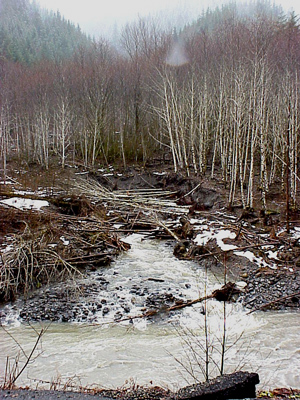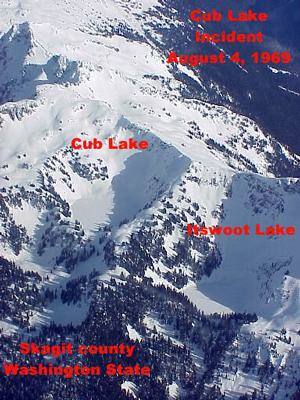Giganto: The Real King Kong… Part III
Posted by: Rick Noll on December 18th, 2005

(William S. Burroughs – Is Everybody In)
1. Get to the other side of the river. A 100 year storm had washed out bridge access to the southern section of our study area. It had been closed down now for about 3 years. This storm trapped me in the area with landslides and changed the course of the river. The river has a good history of producing Steelhead and killing people who take the dangers lightly. The moving water, glacial temperatures, sweepers (downed logs in the river) and now quicksand were just a few things that needed to be figured in our planning changes.

2. Visit the chute meadows and funnels. Evaluate just what edible plant life was there. The meadows would provide a plentiful food supply, allowing thermo regulation of large bodied animals at the same time. The funnels allowed easy, unseen entrance and egress for animals to visit the meadows.

3. Daily searches of the 26 miles of sand bars along the river. Visiting those sites containing small mammals burrowing beneath the sands and beaver ponds along the shores. Mountain beaver was a very big to do on the horse wranglers list.

4. Deploy the ARU (Automated Recording Unit), conduct control checks with a known distance, direction and power level call blast from base camp. This unit recorded sound, both in the audible range and that from the infrasound level.
5. Deploy 30 camera traps forming a line along the northern side of the river.
6. Investigate all entrance routes to the main study area. Evaluate travel routes, shelter, water and food in these locations.
7. Aerial survey of the site.
8. Collect DNA in the form of hair and scat samples. Hair snares were developed and deployed by John Mionczynski. The simple, but effective devices not only snagged hair from a warm body but also would dig a little bit at the skin, hopefully bringing along with it a follicle, tissue and blood.

9. Visit sites within the study area where historical as well as more modern reports of giant apes have emanated (Cub Lake, White Film, Hairy Pants berry fields, etc.).

About Rick Noll
Rick Noll has been actively searching for the Sasquatch since 1969 and continues his pursuit with extended field trips into the Pacific Northwest's most remote regions. Rick has worked with Peter Byrne, René Dahinden, Grover Krantz, John Green, Jeff Meldrum and the BFRO during all this. He helped with many documentaries on the subject including Animal X: The Skookum Expedition and Sasquatch: Legend Meets Science.










Could you expalin what you mean by funnel into chute meadows and what you consider to be chute meadows? Thanks Brian
Chute meadows are steep sided areas on small mountains, below timberline. It could be a combination of steepness, type of soil and wintertime avalanches that create and maintain low level plant growth on them. Many berries grow on them, as do nettles.
The meadows can be used for regulating body temperature; during different seasons and even times of the day, north, west, south and east facing hillsides provide needed shade or sun, heat or cold and moisture or dryness.
Water run off always seeks the lowest level and while traversing down the hillside with form deep gullies, acting as funnels for anything falling off the chute meadows.
These funnels usually have taller plant life growing than on the meadows.
Chute meadows are a favorite spots for mountain gorillas in Africa to feed, sleep and do whatever else they want to do.
Today on animal planet was a program called Gorilla that focused on the lowland Gorillas using the type of areas, even showed them wading waist deep in the creeks feeding.
could you post a photo of the cleaned up cast shown at the end of the program?
Mr. Coleman,
Can you explain to me how it was concluded that GIGANTOPITHECUS BLACKI was an ape and not just some giant hairy human?
I seem to remember a controversy regarding this and some commentary by some individuals of the cryptozoological and paranormal realms in regards to the identity of such a creature.
How did mainstream science ever come to the conclusion that gigantopithecus was an ape?
BG
Does anyone know if the show will is going to be aired again? I only caught the last 15 minutes, unfortunately.
To The Toad,
Yes Giganto will be re-aired Dec. 21 along with Ancient Mysteries with segments on Bigfoot, Yeti, and the Loch Ness Monster.
It will air during prime time and be repeated later in the evening.
Good luck,
Chris B.
Bluewater,
Thank you! I’ll be tuned in for sure this time.
I see that “batgirl” has attributed something to me that I didn’t say. 🙂
Anyway, wanted to stop by here to say my posting on Gigantopithecus versus Paranthropus is online now, at
Rick,
Thank you for including photos with all your posts. These really help tell & show where you’re doing your work in the present along with the past work you have done.
When you have time could you talk more on the ARU’s on a full post or a few. I first read about these a few years back on the Cornell web site.
Once again great work.
Chris B.